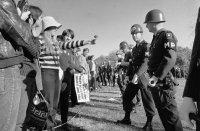It wasn't bad apples, folks. I've said it before, but the proof is in. Read Kathrine Eban's jaw dropping exposé in Vanity Fair.
Eban's article provides the first ever eye witness accounts of a CIA interrogation at a "black site"; it explains the role of two psychologists, James Elmer Mitchell and Bruce Jessen, in devising the techniques that proliferated all combat operations of the War on Terror; it explains how those techniques were reverse engineered from the SERE military training program to condition soldiers to resist torture by enemies who do not follow the Geneva Conventions; and it provides documentation of Standard Operating Procedures that began at Gitmo, which include specific instructions for how to avoid leaving physical marks while torturing detainees.
Some key points:
- CIA "enhanced" techniques did not get "high-value" detainee Abu Zubaydah to spill the beans; traditional, humane rapport building by FBI agents was what yielded intelligence about 9-11 mastermind Khalid Shaikh Mohammed.
Zubaydah was stabilized at the nearest hospital, and the F.B.I. continued its questioning using its typical rapport-building techniques. An agent showed him photographs of suspected al-Qaeda members until Zubaydah finally spoke up, blurting out that "Moktar," or Khalid Shaikh Mohammed, had planned 9/11. He then proceeded to lay out the details of the plot. America learned the truth of how 9/11 was organized because a detainee had come to trust his captors after they treated him humanely.
It was an extraordinary success story. But it was one that would evaporate with the arrival of the C.I.A's interrogation team. At the direction of an accompanying psychologist, the team planned to conduct a psychic demolition in which they'd get Zubaydah to reveal everything by severing his sense of personality and scaring him almost to death.
- The techniques seen at Abu Ghrai---for which enlisted military personnel took the fall---were devised by James Elmer Mitchell and Bruce Jessen, two psychologists who had no real-life experience using the tactics they devised.
Psychologists, working in secrecy, had actually designed the tactics and trained interrogators in them while on contract to the C.I.A.Both [Mitchell and Jessen] worked in a classified military training program known as SERE—for Survival, Evasion, Resistance, Escape—which trains soldiers to endure captivity in enemy hands. Mitchell and Jessen reverse-engineered the tactics inflicted on SERE trainees for use on detainees in the global war on terror, according to psychologists and others with direct knowledge of their activities. The C.I.A. put them in charge of training interrogators in the brutal techniques, including "waterboarding," at its network of "black sites." In a statement, Mitchell and Jessen said, "We are proud of the work we have done for our country."
The agency had famously little experience in conducting interrogations or in eliciting "ticking time bomb" information from detainees. Yet, remarkably, it turned to Mitchell and Jessen, who were equally inexperienced and had no proof of their tactics' effectiveness, say several of their former colleagues. Steve Kleinman, an Air Force Reserve colonel and expert in human-intelligence operations, says he finds it astonishing that the C.I.A. "chose two clinical psychologists who had no intelligence background whatsoever, who had never conducted an interrogation … to do something that had never been proven in the real world."
The tactics were a "voodoo science," says Michael Rolince, section chief of the F.B.I.'s International Terrorism Operations. According to a person familiar with the methods, the basic approach was to "break down [the detainees] through isolation, white noise, completely take away their ability to predict the future, create dependence on interrogators."
- After being introduced at one or more black sites in spring 2002, the Mitchell/Jessen SERE torture techniques became Standard Operating Procedure at Guanatanamo Bay by late 2002. We've long known about Rumsfeld's authorization of "enhanced techniques," but Eban has found what appears to be an authorization memo with full instructions for how do torture "right." Only after becoming Standard Operating Procedure at Gitmo did US torture techniques make their way to Iraq.
Just months after Zubaydah's interrogation, the myth of Mitchell and Jessen's success in breaking him had made its way from Thailand to Guantánamo to Washington, and the reversed sere tactics had become associated with recognition and inside knowledge.
In late spring, Mallow met with Major General Michael E. Dunlavey, who was about to take over as commander of the newly combined JTF-GTMO 170 (Joint Task Force Guantánamo). Mallow briefed Dunlavey on his bsct team's rapport-building efforts and offered him full access to the psychologists. About a month later, he claims, Dunlavey had appropriated the acronym but set up a separate bsct team, cobbled together in part from clinical psychologists already at Guantánamo. Before activating the new bsct team, Dunlavey sent its members to Fort Bragg for a four-day sere-school workshop. (Dunlavey, now a juvenile-court judge in Erie, Pennsylvania, did not respond to requests for comment.)
On December 2, 2002, Secretary of Defense Donald Rumsfeld granted JTF-GTMO 170's request to apply coercive tactics in interrogations. The only techniques he rejected were waterboarding and death threats. Within a week, the task force had drafted a five-page, typo-ridden document entitled "JTF GTMO 'SERE' Interrogation Standard Operating Procedure."
The document, which has never before been made public, states, "The premise behind this is that the interrogation tactics used at US military sere schools are appropriate for use in real-world interrogations" and "can be used to break real detainees."
The document is divided into four categories: "Degradation," "Physical Debilitation," "Isolation and Monopoliztion [sic] of Perception," and "Demonstrated Omnipotence." The tactics include "slaps," "forceful removal of detainees' clothing," "stress positions," "hooding," "manhandling," and "walling," which entails grabbing the detainee by his shirt and hoisting him against a specially constructed wall.
"Note that all tactics are strictly non-lethal," the memo states, adding, "it is critical that interrogators do 'cross the line' when utilizing the tactics." The word "not" was presumably omitted by accident.
UPDATE
I should not have used "Voodoo" as a pejorative term. Go here to read why.














Recent Comments